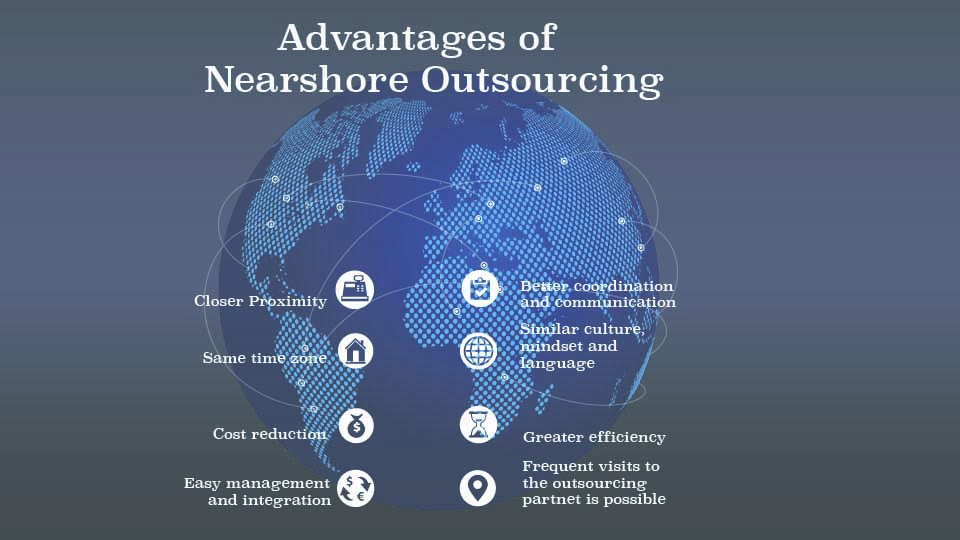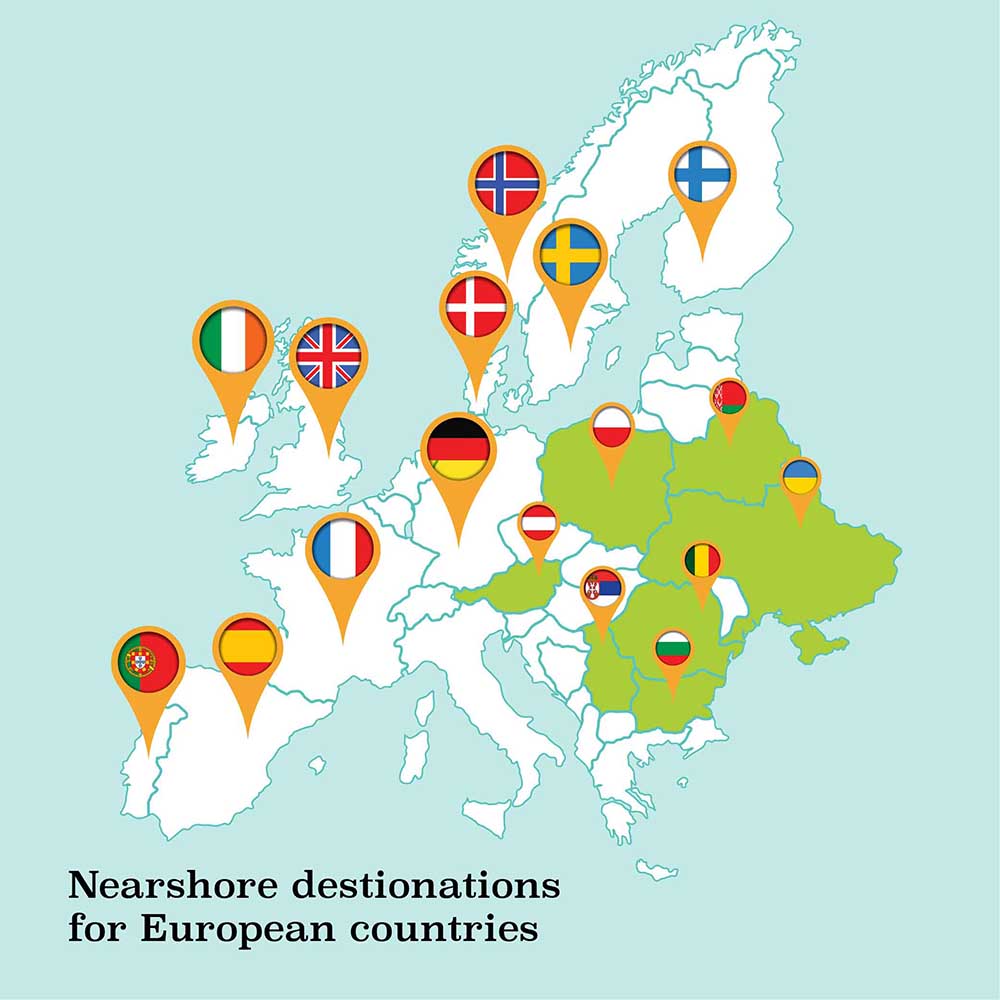
Onshore, offshore and nearshore software development. The pros and cons of having a nearshore team in Eastern Europe
A typical startup is made up of three people: a founder that manages the day-to-day proceedings, a co-founder that solves the inevitable technical issues and another another team member who deals with all the rest. There's a general belief that hiring a few new people to spread the workload and operate more efficiently is a sensible thing to do. Unfortunately, startups often have very limited resources for that purpose and it costs a lot of money to employ new staff.

Middle-sized IT companies, on the other hand, are always trying to find new people as quickly as possible, so that they can keep supplying their rapidly growing teams with professionals.
In both of these cases outsourcing can come in handy. It helps companies to find the right people or to work out speedy solutions for a reasonable amount of money - in most cases startups can adopt outsourcing in combination with other hiring methods.
But as useful as it can be, software outsourcing does come in different shapes and sizes, so it takes time to workout exactly what to opt for. While deciding on what work to outsource and which hiring method to use, one should also carefully consider the location of the potential outsourcer.
Similar but different
Some outsourcing destinations are too far away, and differences in cultural background can cause issues with personal communication. The location may also cause problems in managing the outsourced tasks. Other aspects, such as the time zone, the primary language spoken, the level of wages, should all be kept in mind when choosing the “right” location.
Besides, outsourcing software development is not about hiring the cheapest contractor - it’s about getting the very best price to quality ratio. And the search for this match can be easier when you know that there are just three possible scenarios when looking for an outsourcing company: you can onshore, offshore, or nearshore.

Onshore is when you choose software development outsourcing firms located in the same country as your business. Offshores are located on other continents, whereas nearshores work in a similar way to the offshores, except you share the same or similar time zone and sometimes even currency.
Choosing an offshore provider is usually the best option in terms of costs, although the time zone and cultural differences may cause communication barriers.
Read how to evaluate an offshore outsourcing vendor
Onshore solutions in turn are quite expensive, especially if you are trying to find a partner in a developed country like the US or the UK. So if the onshore costs are too high for you, then a nearshore company may be a great option: the prices will be lower than in your company’s home country and the competition for tech talent will be less intense.
For clients in the United States, nearshoring means working with countries like Mexico, Canada, and Puerto Rico. For those in Israel and Western Europe, nearshoring means Eastern European countries, including also Ukraine and Belarus.
Smaller geographical distances and less prominent cultural barriers are some of the reasons why communication and management with nearshoring is on the whole much easier than offshoring. Although of course, time should still be taken to make a thorough plan and consider all the possible eventualities.
When outsourcing software development to contractors from neighboring countries, you still have to make sure that all the details are agreed upon and that you both understand each other - team abilities and project specification should be cautiously assessed.
Read about software developers in Ukraine
Geography matters
Throughout the different project stages, providers should also talk to contractors, gaining multiple points of view in order to reach a deeper level of partnership. It is, however, always better to compose a thorough, final version of the specification, minimising the need for later adjustments to the project details.
All of these best practices are typically followed by software developers from Eastern Europe, as their attitude is usually pro-active and knowledgeable. As a result, professionals from this region can definitely be recommended for their cooperative approach and ability to work on the hardest tasks.
Eastern Europe offers high standards, mainly thanks to a high level of communication and the excellent technical skills of its developers. In Ukraine, for example, there are around 100,000 IT specialists and most of them speak fluent English; the country also has comparatively low taxes and favorable legislation (e.g. Ukrainian laws allow invoicing and contracting completely via e-mail).
The region, along with the Baltics and the Balkans, has become more open and visible in recent years. The combination of budding talent, good universities and lower labor costs means that it is now well established as a serious partner for worldwide IT leaders, especially those in the western parts of Europe where there are no borders and even the currency is the same.

Making the right choice
The technological landscape is changing and this change requires companies to accelerate their pace of development to keep up with the industry leaders or (what’s even harder) to try to stand out. This especially concerns the IT industry, where thousands of startups are born and die every day - most tech companies are challenged to achieve accelerated product development, diverse technical expertise, and fast prototyping of new products and services.
Software development outsourcing is certainly a tool to help companies cope with this increased pace, and there is an acknowledged inclination towards nearshoring in Eastern Europe to maximize the use of this tool and to meet the challenges facing today’s tech startups. The reasons are many, including cultural alignment, better business and market understanding, proximity, agility, and well-written laws that ensure business data security. Besides, legal and financial issues are no problem for Western Europe - almost all the countries in the region are members of the European Union. For countries like Israel, Eastern Europe is the closest, most developed neighbor located across the sea.
But along with the benefits that Eastern Europe has to offer, there are also some disadvantages - the main one being high cost, especially when compared with the prices charged by software developers in countries like India and China.
Another issue is the biggest legacy left by the Soviet Union in this region - mentality. It sometimes affects company managers’ relationships with customers. This situation, however, is changing.
Ukraine can serve as a good example of this transformation - the country has signed agreements permitting visa-free travel and trade with the EU, as it starts to emerge as a potential leader in the Eastern European IT industry, especially when it comes to software development.
There are myriad advantages you can gain, from cost saving to allowing to spend more time on pre-launch and marketing efforts. You’ll find that when outsourcing mobile app development, you can act as a supervisor, overseeing all aspects of the project while remaining at a distance and being able to work on other business processes.
In any case, when contracting with an Eastern European country, you should work hard to establish a proper level of communication, especially if it’s a small firm that is new to the market.
Business relationships with outsourcing companies are very often about gaining either trust or full control over the process. And maybe nearshoring is what can suit both of these requirements - an hour’s travel and you can meet the team you’re working with face-to-face, allowing you to develop trust or oversee what they are doing. Although nearshoring isn’t exactly a silver bullet, it can highly improve your chances of finding just the right software outsourcing contractor.
Written by Denys Krasnikov



